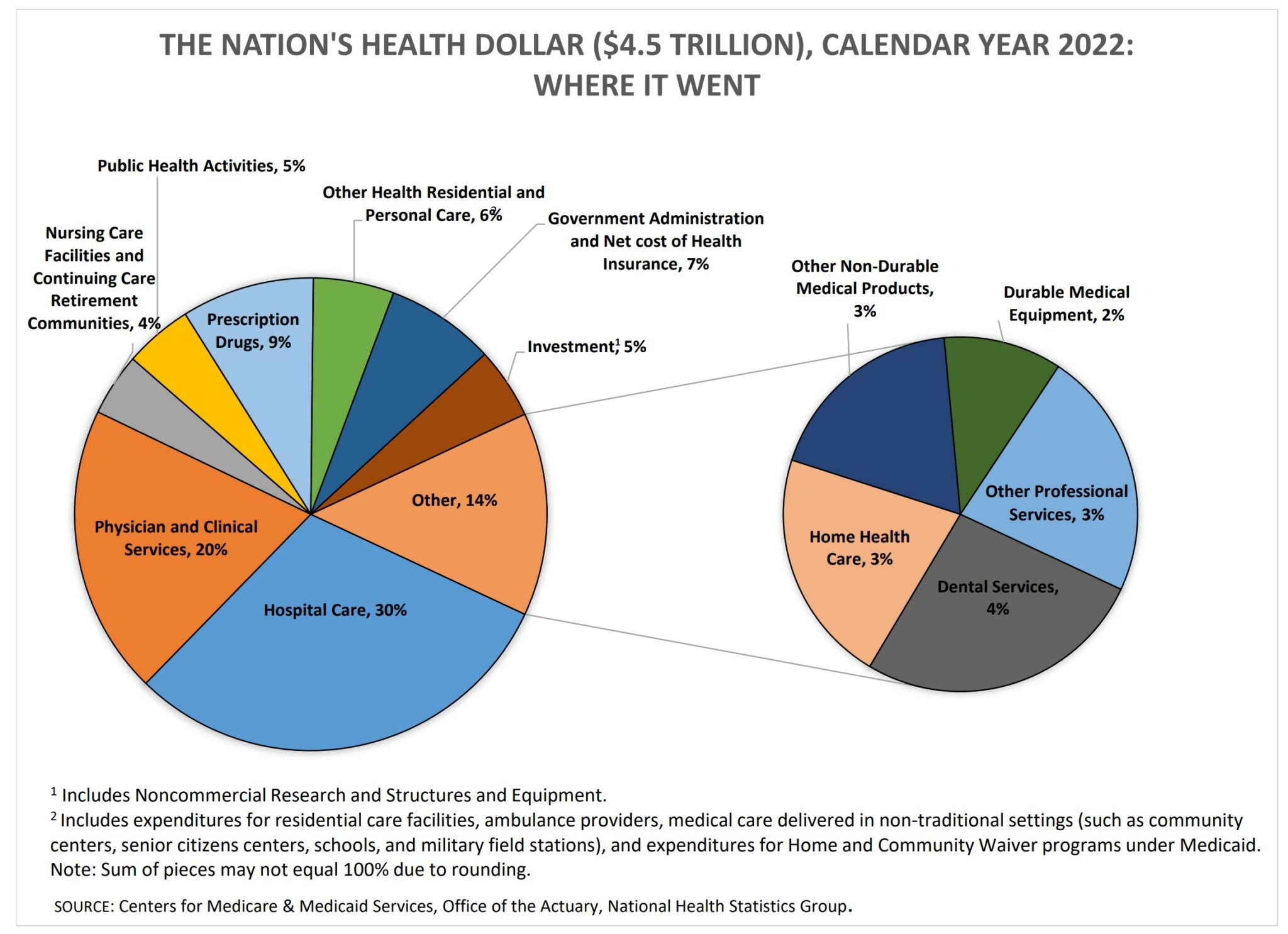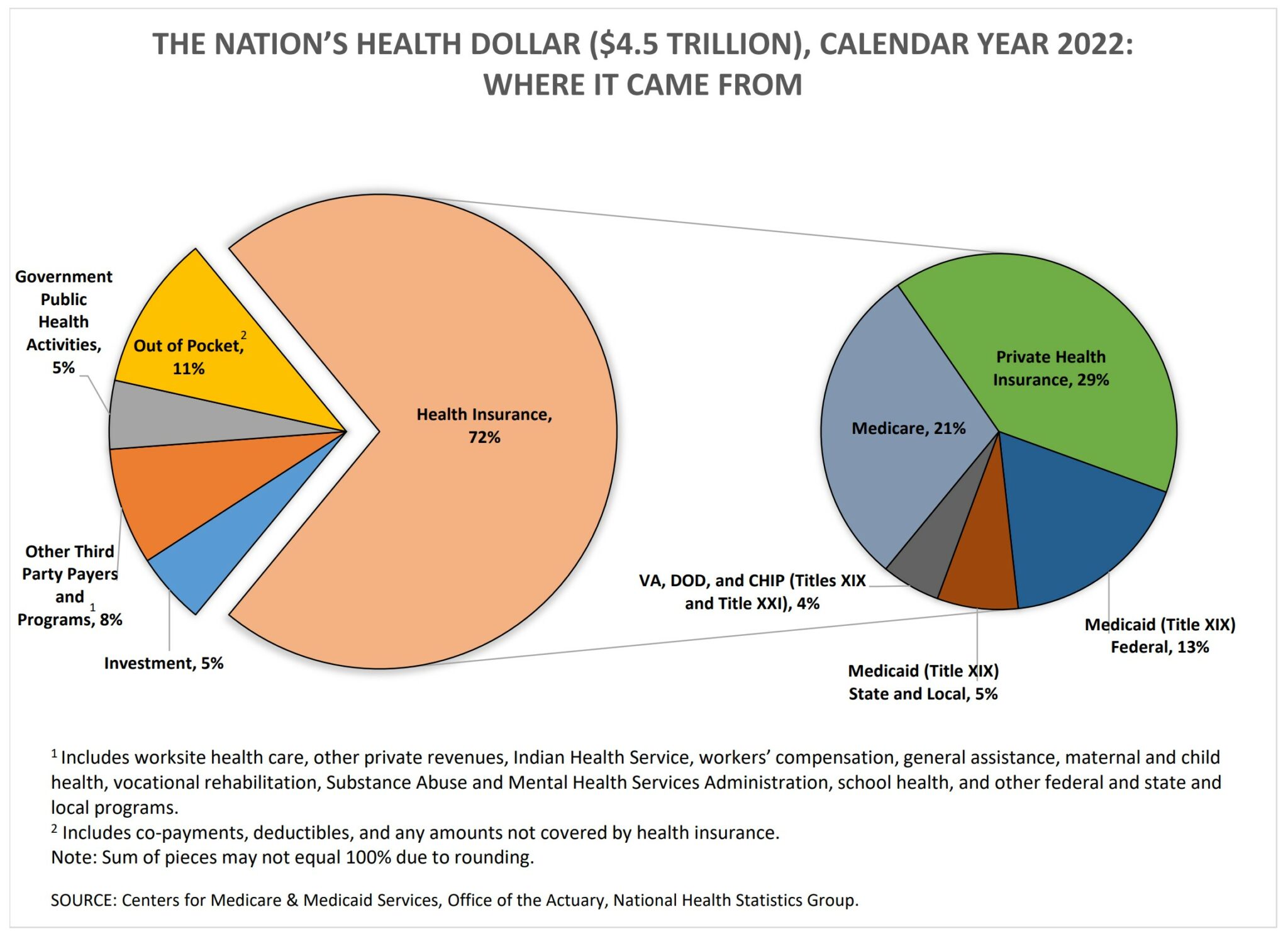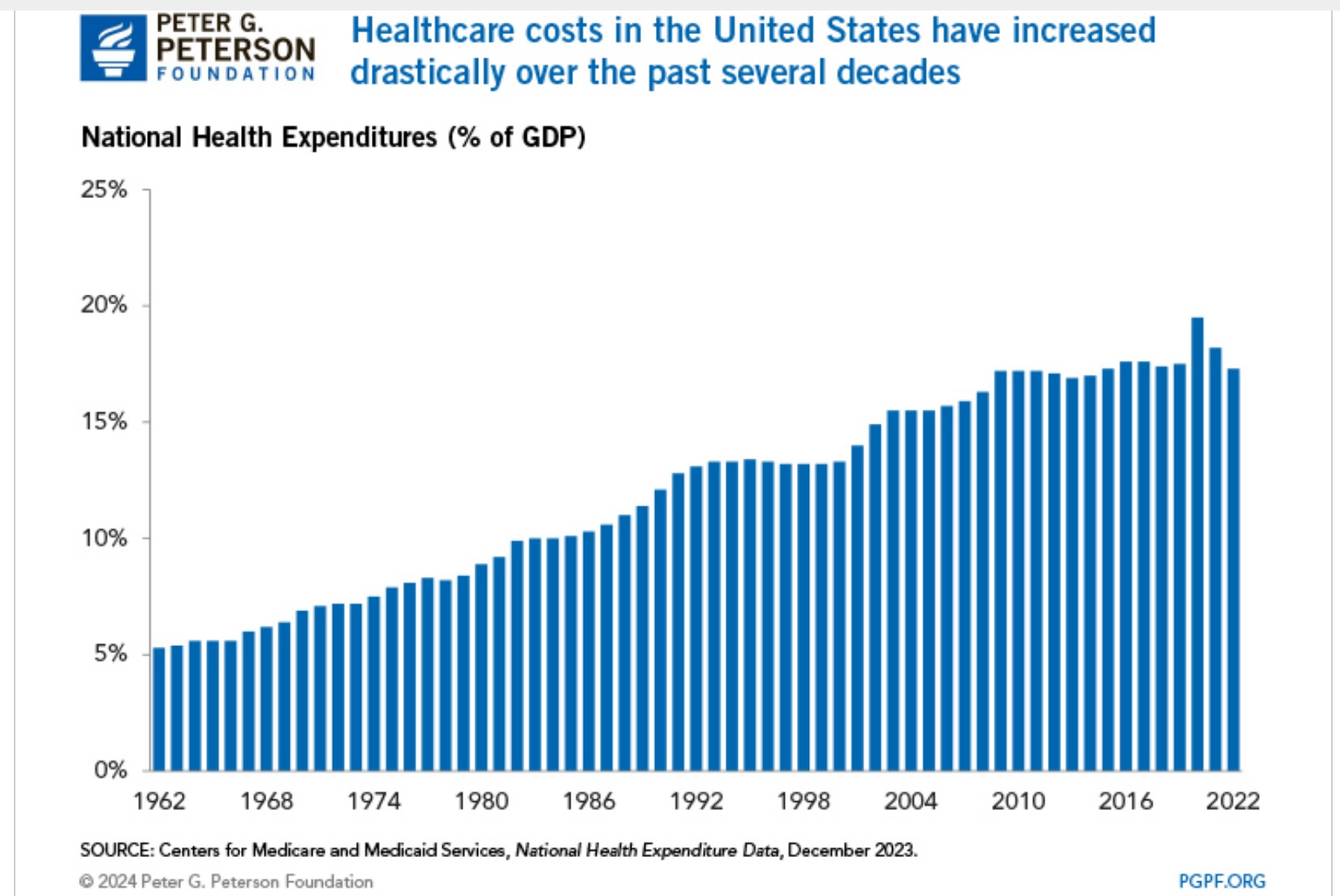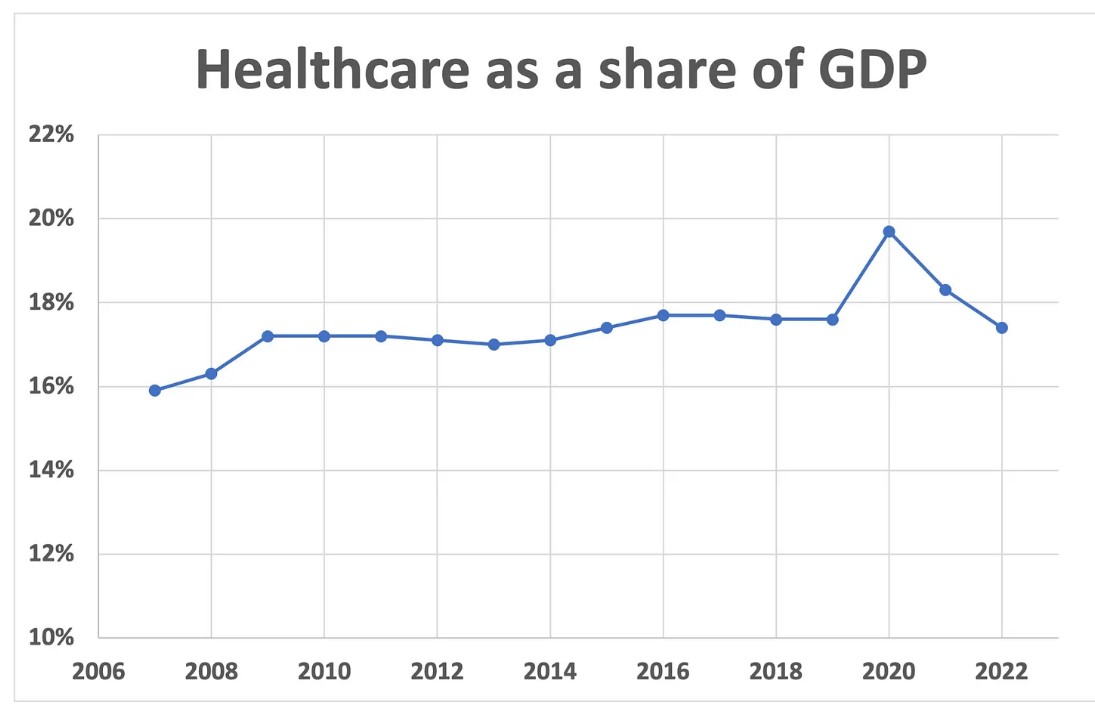Yves right here. We wrote recurrently across the time of Obama Grand Discount try at how the CBO performed the position of unrepentant neoliberal enforcer. We weren’t alone in disapproving of the doubtful budgetary strategies the CBO and its outsized position in setting coverage.
The submit beneath from Offended Bear describes, opposite to CBO and CMS forecasts, healthcare prices in mixture (as in as a % of GDP) will not be rising. That is opposite to earlier, insistent predictions that well being care prices would proceed to rise and can proceed to extend in GDP phrases.
Not that the present 17.8% of GDP is an effective quantity, thoughts you. The truth that that determine is so out of line with that of different superior economies illustrates how a lot worth gouging and different affected person abuses are happening (don’t get me began on overtesting…..)
Invoice Haskell cites an article that expresses mystification as to why the CBO and CMS forecasts proceed to insist on important aggregage well being care price will increase. The CBO had been utilizing a bogus methodology to estimate well being care price will increase, one which violated its personal stipulated methodologies. Excessive projected well being care price will increase would serve to justify extra beating of the poors and center class, through Medicare and Medicaid cuts.
Instantly beneath we quote from a 2012 submit. Maybe readers on this beat can level us to newer CBO analyses so we are able to confirm the place and the way the CBO is taking part in medical price forecast video games now. Invoice Haskell at Offended Bear factors to a CBO letter: any assist in discovering different key paperwork can be very a lot appreciated.
From Fed Budgetary Consultants Demolish CBO Well being Value Mannequin, the Linchpin of Finances Hysteria:
A remarkably necessary and persuasive paper that calls into query the necessity for “reforming” Medicare has not gotten the eye it warrants. “An Examination of Well being-Spending Development In The USA: Previous Tendencies And Future Prospects” (hat tip nathan) by Glenn Follette and Louise Sheiner seems to be on the mannequin utilized by the Congressional Budgetary Workplace to estimate long run well being care price will increase. Keep in mind that this mannequin is THE driver of nearly all forecasts of future funds deficits.
This paper, though written in usually anodyne economese, is devastating within the vary and nature of its criticisms. And the rationale this evaluation ought to be taken critically, unbiased of the significance of the problems it raises, is that the authors are uniquely certified to make this critique. Follette is chief of the Fed’s fiscal evaluation part. Sheiner, a fellow member of that group, has labored for each the Treasury and the Council of Financial Advisers beforehand. In different phrases, the kind of evaluation they’ve made right here is the core of what they do each day.
The argument made by the opponents of the plans to chop Social Safety and Medicare typically take this type: issues about Social Safety are significantly exaggerated. They’re primarily based on long-term forecasts, that are notoriously inaccurate in outlying years. Essentially the most generally cited, by the Trustees of the Social Safety system, initiatives the exahustion of the well-known belief fund in 2033. As a number of analysts have noticed, if Social Safety actually has an issue, we’ll realize it in loads of time; there’s no have to do something instantly.
Against this, standard knowledge is that Medicare does have a long run price predicament, however the issue just isn’t demographic, however that of the steep rise of well being care prices generally.
The basic beef of Follette and Sheiner with the CBO mannequin is that it naively assumes previous progress in well being care spending as the idea for its long-term projections. The result’s that it reveals that timber will develop to the sky. One of many issues anybody who has constructed forecasting fashions will let you know is you give you assumptions that look affordable after which sanity verify the output (for example, does your mannequin say in 12 months 10 that your revenues can be 3x what you possibly can produce given your forecast degree in plant and funding? In that case, you want to make some revisions). The Fed economists level out quite a few ways in which the mannequin output flies within the face of what quantities to widespread sense on this planet of long run funds forecasting. From the opening of the paper (emphasis ours):
Lengthy-run projections of the U.S. federal funds have performed a distinguished position in discussions about fiscal coverage and the design of main switch applications for a number of many years. The projections usually present giant fiscal imbalances owing to ramping up of retirement and well being care prices relative to GDP. Well being care prices are the important thing think about these projections for 2 causes. First, in present projections they’re the prime supply of progress of spending as a share of GDP. Second, they’re essentially the most unsure a part of the forecast. For instance, the Congressional Finances Workplace’s most up-to-date long term outlook reveals spending on Medicare and Medicaid, the governments well being applications for the outdated and poor, respectively, rising from 4.1 per cent of GDP in 2007 to 19.1 per cent of GDP in 2082.1 Against this, Social Safety advantages (the federal government’s essential old-age pension program) improve solely 2 share factors, from 4.3 per cent of GDP in 2007 to six.4 per cent in 2082. One other evaluation by CBO means that an 80 per cent confidence band across the Social Safety projection can be from 51⁄2 to 91⁄2 per cent of GDP.2 CBO didn’t current related calculations for well being spending; as an alternative, they projected well being spending below three completely different assumptions concerning the fee of progress of age-adjusted well being care spending in extra of per capita earnings. Their projections present well being spending starting from 7 to just about 40 per cent of GDP by 2082.
By comparability, protection spending as a % of GDP peaked at 42% of GDP in World Struggle II. A mannequin that presents as a attainable end result that the US will commit practically 40% of GDP to well being care spending a long-term, sustained end result, is ludicrous on its face.
There are much more forecasting crimes in that mannequin, together with violating the CBO’s personal methodologies, however the extract above provides a drift of the gist.
The truth that particular person readers could also be experiencing painful healthcare prices is unfortunately an present situation, and our fragmented insurance coverage and supply system means too many individuals are uncovered to random or unfair dangerous outcomes. Misrepresenting total prices to squeeze sufferers additional is simply one other rentier enrichment scheme.
Now in equity, as many readers know, now we have the possible coming burden of upper well being care prices within the type of Covid-related morbidities, as in additional individuals getting sicker at youthful ages than the prototypical improve as one will get to be of their 60s. However this may occasionally not play out as in a easy method. As an example, Covid appears to be harming fertility. So an anticipated end result there’s fewer pregnancies and births versus extra spending on fertility remedies. How will these two forces web out spending-wise? So though the general Covid impression is fairly certain to be destructive, it’s a sophisticated image…and naturally, given our dreadful public well being institution, we lack good knowledge. And that can enable the CBO to once more exaggerate the trajectory to help deeper-than-warranted cuts.
By Invoice Haskell. Initially revealed at Offended Bear
I’m making an attempt to current a easy approach to painting the prices of healthcare within the US. Utilizing pie charts, a bar chart, and a graph will get the measures of price throughout and on the similar time presents completely different dialogue factors. Merrill Goozner presents the identical knowledge as did Peterson and attracts a unique conclusion. Healthcare prices don’t look like outstripping financial progress. The difficulty nonetheless stays that we are able to handle our healthcare prices in a extra environment friendly method. The opposite situation introduced right here? CMS and CBO reporting needs to be correct because it drives what the federal government does.
The Nation’s Well being Greenback ($4.3 Trillion), Calendar 12 months 2022: The place It Got here from and The place it Went, (cms.gov)
The place Did We Spend the Cash for Healthcare?

From The place Did the Funding for Healthcare Come?

A Story of Two Healthcare Spending Charts and Why.

Why Are People Paying Extra for Healthcare? pgpf.org.
Usually, healthcare spending might be regarded as a operate of worth ({dollars} charged for healthcare providers) and utilization (the quantity of providers used). There are a number of underlying components that may improve worth and utilization, thereby boosting spending on healthcare. Essentially the most notable of these components are an growing old inhabitants and healthcare costs.
An Growing old Inhabitants
The share of the U.S. inhabitants age 65 and over has elevated over the previous a number of years, rising from 14 % in 2012 to 17 % in 2022. Moreover, that quantity is projected to proceed climbing – reaching 21 % by 2032. Since individuals age 65 and over, on common, spend extra on healthcare than another age group, progress within the variety of older People is anticipated to extend complete healthcare prices over time.

Why do the well being economists preserve getting it mistaken? GoozNews, Merrill Goozner. June 2023
Merrill: For greater than a decade, CMS and CBO persistently overestimated the expansion in well being care spending, which undermines efforts to spend extra on health-related social wants.
Earlier at this time, economists on the Facilities for Medicare and Medicaid Providers launched their annual projection for well being care spending over the subsequent decade. After noting that spending fell to 17.4% of gross home product in 2022, which is about the place it’s been for many of the previous decade besides in the course of the Covid years, they predicted spending by Medicare, Medicaid, personal insurance coverage and different private and non-private entities would as soon as once more resume its upward trajectory this 12 months and attain practically 20% of GDP by 2031.
Hmmm. The place have I heard that earlier than? I preserve a file containing previous CMS projections so it was pretty straightforward for me to verify. The earliest article in my file dates from February 2008, when well being care made up 16% of the general economic system. That 12 months, CMS predicted spending would attain 20% of GDP by 2017.
Let’s go to the videotape. Seven years after President Obama and the Democratic Congress handed the the 2010 Reasonably priced Care Act, which included quite a few provisions aimed toward reining in well being care spending, it had solely reached 17.7% of GDP.
The CMS prognosticators in the course of the first 12 months of the Trump administration didn’t do significantly better. In 2017, they predicted healthcare would attain practically 20% of the economic system by 2025. Now they’re saying it gained’t attain that degree till 2031.
To be truthful, healthcare spending did spike to just about 20% of GDP in 2020. However that was solely as a result of the pandemic dramatically slowed total financial exercise whereas the federal government poured money into hospitals and doctor places of work to maintain them working. It took solely two years for it to fall again into the 17-18% of GDP vary because the economic system recovered and the stimulus was withdrawn.
One may conduct an analogous train with healthcare spending projections from the Congressional Finances Workplace. Happily, I don’t must do the calculations as a result of Sen. Sheldon Whitehouse (D-RI), chairman of the Senate Finances Committee, requested CBO director Phillip Swagel that very query.
Swagel replied in a letter earlier this 12 months that CBO overestimated obligatory spending for well being care within the 2010–2020 interval by 9%. He wrote: “Many of the overestimate for the Medicaid and Medicaid applications stemmed from an overestimate of spending per beneficiary, not an overestimate of the variety of beneficiaries.”
AB: There are repercussions for overestimating spending for well being care.
This systematic overestimation of future well being care prices by authorities economists has far-reaching penalties. When CMS will get it mistaken, organizational planners across the nation are given a defective notion of how a lot cash can be flowing via the system, which may result in a misallocation of assets.
When CBO will get it mistaken, Congresspersons get a defective notion of what assets can be found to spend on different applications. It additionally feeds the GOP’s hysteria round balancing the funds, which undermines political help for different social applications, together with people who would truly enhance the well being of the nation.
AB: In the event you get an opportunity, learn the CBO letter which supplies a very good assessment of healthcare spending and their miscalculations.
